Uncategorized
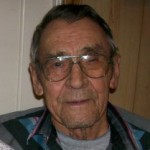 It makes me sad to think that my father-in-law, Walt Schulenberg has been in Heaven now for over 5 years….not sad for him, but for me. He was such a sweet man, and having him for a father-in-law was always a blessing. When I first met my father-in-law, I liked his sense of humor, his willingness to help others, and his love of family. Early on, I probably would have said that my husband was very different that his dad, but as time went on, I realized that he really wasn’t. I discovered that the traits that I love about my husband came to him from his parents, and especially his dad. I think that is more common than we know, and the older each of us gets, the more we notice the traits of our parents. It is very much their legacy, living in their children.
It makes me sad to think that my father-in-law, Walt Schulenberg has been in Heaven now for over 5 years….not sad for him, but for me. He was such a sweet man, and having him for a father-in-law was always a blessing. When I first met my father-in-law, I liked his sense of humor, his willingness to help others, and his love of family. Early on, I probably would have said that my husband was very different that his dad, but as time went on, I realized that he really wasn’t. I discovered that the traits that I love about my husband came to him from his parents, and especially his dad. I think that is more common than we know, and the older each of us gets, the more we notice the traits of our parents. It is very much their legacy, living in their children.

I began taking care of my in-laws in 2007, and my father-in-law was somewhat surprised that I would devote so much time to them, but in reality, they were like second parents to me, and they had given me so much…not just in things, but in the gift of their wonderful son to be my life partner. They showed him how to be the amazing man I married, so how could I possibly not show them how great I knew they were. Life is a cycle. We raise our children with the hope that they will find someone to share their life with, and who will share their family too. My father-in-law was a great dad to his kids, in-laws, and grandkids. I feel very blessed to have known him.
 Dad was a great teacher. He taught both of his boys to work on cars, build things, and to be responsible hard working men. His boys, and his girls too, have all become responsible, successful people, who all helped to take care of their parents as the end approached. It was their way of giving back to the wonderful people who raised them. It is sad to know that they have passed on now, and we do miss them very much, but we also know that they are not hurting or suffering in any way now, and that makes the pain of loss easier to bear. Today would have been my father-in-law’s 89th birthday. Happy birthday in Heaven, Dad. Thank you for the gift of your son, Bob, who is the love of my life. You raised him well. We love and miss you very much, and look forward to seeing you again in Heaven.
Dad was a great teacher. He taught both of his boys to work on cars, build things, and to be responsible hard working men. His boys, and his girls too, have all become responsible, successful people, who all helped to take care of their parents as the end approached. It was their way of giving back to the wonderful people who raised them. It is sad to know that they have passed on now, and we do miss them very much, but we also know that they are not hurting or suffering in any way now, and that makes the pain of loss easier to bear. Today would have been my father-in-law’s 89th birthday. Happy birthday in Heaven, Dad. Thank you for the gift of your son, Bob, who is the love of my life. You raised him well. We love and miss you very much, and look forward to seeing you again in Heaven.
 In most ways, my grand-niece, Zoey Iverson is a typical little girl, who happens to be turning three years old, but in other ways, she certainly is not. Zoey loves to watch crafting videos on YouTube, not a common hobby for most three year olds, but one that is likely less annoying to her parents than some of the cartoons these days. Knowing that Zoey watches You Tube is not really surprising, but her taste in videos really is. It is making me wonder if there is a bit of artist’s blood in her veins. I have great respect for those who can do crafts, and if this little girl is learning how to do these things now, she will be good at it.
In most ways, my grand-niece, Zoey Iverson is a typical little girl, who happens to be turning three years old, but in other ways, she certainly is not. Zoey loves to watch crafting videos on YouTube, not a common hobby for most three year olds, but one that is likely less annoying to her parents than some of the cartoons these days. Knowing that Zoey watches You Tube is not really surprising, but her taste in videos really is. It is making me wonder if there is a bit of artist’s blood in her veins. I have great respect for those who can do crafts, and if this little girl is learning how to do these things now, she will be good at it. 
Zoey also loves camping with her family, and fishing with her daddy. She and her daddy are really buddies, but don’t think that Zoey doesn’t have a girlie side. Zoey loves to dress up as a princess, and she can never get enough bath time. For anyone who loves a nice warm soak, especially with bubbles, Zoey’s love of a bath makes perfect sense. She also loves to play pretend with her toys, and she is learning her animals.
I think her biggest job, and her greatest accomplishment is helping her brother eat and learn new things. Her  brother was born with Down’s Syndrome, and Zoey has taken it upon herself to help him learn as much as she can teach him, because Zoey loves her brother, Lucas very much. He is her hero in many ways, and she is a hero to him too…though she may not realize that. Zoey is a sweet girl with a caring heart and she is a great blessing to her family and all who know her. Zoey is growing up very fast, and in many ways, is already wise beyond her three years. Some kids are like hat, and Zoey, loves to take care of others, especially her big brother. I know that she is going to be a wonder little three year old and a great girl, as she grows up too. Today is Zoey’s 3rd birthday. Happy birthday Zoey!! Have a great day!! We love you!!
brother was born with Down’s Syndrome, and Zoey has taken it upon herself to help him learn as much as she can teach him, because Zoey loves her brother, Lucas very much. He is her hero in many ways, and she is a hero to him too…though she may not realize that. Zoey is a sweet girl with a caring heart and she is a great blessing to her family and all who know her. Zoey is growing up very fast, and in many ways, is already wise beyond her three years. Some kids are like hat, and Zoey, loves to take care of others, especially her big brother. I know that she is going to be a wonder little three year old and a great girl, as she grows up too. Today is Zoey’s 3rd birthday. Happy birthday Zoey!! Have a great day!! We love you!!
 The Old West was a wild, untamed place, and the people who lived there had to be tough as nails too. During that time, the Indian Territory, now Oklahoma, was considered the most violent of the American territories. Along with the Indians, it served as home to hundreds of outlaws from around the country. These were hardened criminal men, accused of murder, rape, robbery, arson, adultery, bribery, and numerous other crimes. They headed to the Indian Territory, looking for a place to hideout…a place where the lawmen couldn’t follow. The Indian Territory was without law enforcement with the exception of the Indian Nations’ police forces, who had no jurisdiction over the many criminals who had taken flight from other states. It left the outlaws in a place of sweet freedom, from both types of law.
The Old West was a wild, untamed place, and the people who lived there had to be tough as nails too. During that time, the Indian Territory, now Oklahoma, was considered the most violent of the American territories. Along with the Indians, it served as home to hundreds of outlaws from around the country. These were hardened criminal men, accused of murder, rape, robbery, arson, adultery, bribery, and numerous other crimes. They headed to the Indian Territory, looking for a place to hideout…a place where the lawmen couldn’t follow. The Indian Territory was without law enforcement with the exception of the Indian Nations’ police forces, who had no jurisdiction over the many criminals who had taken flight from other states. It left the outlaws in a place of sweet freedom, from both types of law.
Then Judge Isaac Parker was appointed to the Western Judicial District of Arkansas, which included Indian Territory. All that sweet freedom was about to end. Parker decided to bring law and order to the Indian Territory…or at least to the criminal element of it. He commanded about 200 deputy marshals to “clean up” the lawless territory. It was a noble idea that would take years to accomplish, as the deputies struggled to cover some 74,000 square miles in their search for hundreds of wanted fugitives. The occupation of a U.S. Deputy Marshal courted constant danger, so much so that between 1872 and 1896, over 100 deputies died enforcing the law throughout the territory. A number of men made names for themselves working as U.S. Marshals in the Indian Territory. Men such as Heck Thomas, Bass Reeves, Bill Tilghman, Chris Madsen, and dozens of others.
There were also a number of other U.S. Marshals who, more quietly made names for themselves, mainly because they were women. I think that as a woman, I would not be so inclined to head into Indian Territory in those days to “clean up” the place. Women have long been considered a part of the “clean up” crew, but most of the time, it was as homemakers. I don’t think anyone thought they could be successful law enforcement officers…at least not in those days.
One of these brave women was F.M. Miller, who was appointed as a U.S. Deputy Marshal out of the federal court at Paris, Texas in 1891. When she was commissioned, she was the only female deputy working in Indian Territory. She was known to have accompanied Campbell on all his trips. During her tenure, she was mentioned in several newspaper articles including the Fort Smith Elevator on November 6, 1891 that described here as: “a dashing brunette of charming manners.” The article continued by stating: “The woman carries a pistol buckled around her and has a Winchester strapped to her saddle. She is an expert shot and a superb horsewoman, and brave to the verge of recklessness. It is said that she aspires to win a name equal to that of Belle Starr, differing from her by exerting herself to run down criminals and in the enforcement of the law.”
Another article appeared a couple of weeks later in the Muskogee Phoenix on November 19, 1891, which said that she had the reputation of being a fearless and efficient officer and had locked up more than a few offenders. The article continued: “Miss Miller is a young woman of prepossessing appearance, wears a cowboy hat and is always adorned with a pistol belt full of cartridges and a dangerous looking Colt pistol which she knows how to use. She has been in Muskogee for a few days, having come here with Deputy Marshal Cantrel, a guard with some prisoners brought from Talahina. Regarding Miss. Miller’s unique position as Deputy U.S. Marshal, another newspaper commented, “Hopefully in the future, there will be more information on this colorful peace officer.”
Another female U.S Marshal in Indian Territory who showed bravery and skill in her job was a young woman named Ada Curnutt. The daughter of a Methodist minister, Ada Curnutt moved to the Oklahoma Territory with her sister and brother-in-law shortly after it opened for settlers. The 20 year old soon found work as the Clerk of the District Court in Norman, Oklahoma and as a Deputy Marshal to U.S. Marshal William Grimes. Her most famous arrest occurred in March, 1893 when she received a telegram from Grimes, instructing her to send a deputy to Oklahoma City to bring in two notorious outlaws named Reagan and Dolezal who were wanted for forgery. I seriously doubt that Grimes meant for her to go, but all the other deputies were out in the field so Curnutt stepped up to the responsibility. She quickly boarded a train for Oklahoma City. When she arrived she discovered that the two men were in a saloon and quickly made her way there. Upon her arrival she asked a man on the street to go in and tell them that a lady needed to see them outside. The outlaws eagerly went out to meet her. When the two emerged, Ada read the warrants to them and stated that they were under arrest. Heavily armed, the two men laughed at the young woman and thinking it was a joke. They stupidly allowed her to place handcuffs over their wrists. When the captives began to realize that the joke was on them, Curnutt announced to the crowd gathered around them that she was prepared to deputize every man to aide her, if needed. As it turns out, it was not necessary, as she escorted them to the the train station and telegraphed the marshal’s office in Guthrie that she was bringing them in. She was 24 years old at the time. The two forgers 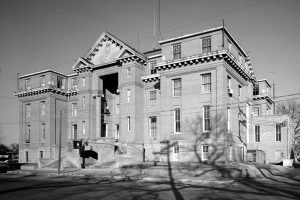 were soon tried and convicted. “Like all deputies of her era, she had to be extremely tough and ready to face a wide range of situations,” the U.S. Marshals Service wrote of Carnutt.
were soon tried and convicted. “Like all deputies of her era, she had to be extremely tough and ready to face a wide range of situations,” the U.S. Marshals Service wrote of Carnutt.
While it was unusual, there were a number of women in law enforcement, even before it was widely accepted as normal. All these women forged the way for the many women we have in law enforcement, and even in the military today. these women may have been the “clean up” crew, but they were a tough as nail clean up crew, and they made, and continue to make, history in the field of law enforcement, and in the military.
 The first time I met my grandniece, Katy Collett, she was a little girl. She was a sweet little girl, who was well behaved, and we all liked her very much. Through the years, Katy has grown into a beautiful young woman, inside and out. Katy is “mom” to two dogs, Bubba and Sheiba, and loves them very much. She and her husband Jake live in the country outside of Casper, Wyoming, so that her babies have plenty of room to run around. Being big dogs causes them to require lots of space. Of course, it doesn’t hurt that Katy and Jake love the outdoors, hiking, 4-wheeling, and such.
The first time I met my grandniece, Katy Collett, she was a little girl. She was a sweet little girl, who was well behaved, and we all liked her very much. Through the years, Katy has grown into a beautiful young woman, inside and out. Katy is “mom” to two dogs, Bubba and Sheiba, and loves them very much. She and her husband Jake live in the country outside of Casper, Wyoming, so that her babies have plenty of room to run around. Being big dogs causes them to require lots of space. Of course, it doesn’t hurt that Katy and Jake love the outdoors, hiking, 4-wheeling, and such.
While Katy loves her dogs, her heart is full of being an aunt, first to Jake’s nephew, and then to her bother, Keifer and his wife, Katie’s daughter, Reece. Katy is a wonderful aunt, doting on the kids as often as she can, and I’m sure they totally love her too. It’s all a part of her caring nature and love of kids. Kids can tell when adults really like being around them, and they warm up to them right away. Of course, I think that Katy will spend a lot of her time wrapped around a certain little girl’s little pinky, because that is what those babies do. They wiggle their way into your heart, and you are lost forever.
Katy and Jake, like most of us, love to travel and they have taken at least one trip to Florida, where his family 
 lives, for a visit. Hitting the Florida coast in mid April is really the perfect time. You can get away from the cold spring weather that still persists in Wyoming at that time of year. Being outdoor people, they prefer the weather in the spring and summer so that it’s more comfortable to get out and do things, and enjoy nature in the warm weather.
lives, for a visit. Hitting the Florida coast in mid April is really the perfect time. You can get away from the cold spring weather that still persists in Wyoming at that time of year. Being outdoor people, they prefer the weather in the spring and summer so that it’s more comfortable to get out and do things, and enjoy nature in the warm weather.
Katy is so sweet and loving to all the people around her, and it has endeared her to all of us. I don’t get to see her as often as I would like, but when we do see each other, it is always a pleasure. Her beautiful smile lights up a room. Today is Katy’s birthday. Katy, I hope your day is as awesome as you are. Happy birthday Katy!! Have a great day!! We love you!!
 My sister-in-law, Jennifer Parmely is a complex woman, who leads a busy life. She is an obstetrics nurse by trade, but that is just her career, albeit a very satisfying one for her. Jennifer knew when she was just 17 years old, that she wanted to be a nurse, and before long, she knew that she wanted to help bring life into the world. She has never changed her mind about that, and has been a nurse at Wyoming Medical Center for about 36 years now. That adds up to a whole lot of babies who can say that Jennifer was there the day they were born. She was the nurse who assisted in the births of all four of my grandchildren. It was very comforting to have her there.
My sister-in-law, Jennifer Parmely is a complex woman, who leads a busy life. She is an obstetrics nurse by trade, but that is just her career, albeit a very satisfying one for her. Jennifer knew when she was just 17 years old, that she wanted to be a nurse, and before long, she knew that she wanted to help bring life into the world. She has never changed her mind about that, and has been a nurse at Wyoming Medical Center for about 36 years now. That adds up to a whole lot of babies who can say that Jennifer was there the day they were born. She was the nurse who assisted in the births of all four of my grandchildren. It was very comforting to have her there.
While nursing is Jennifer’s career, exercise is her passion. She loves all forms of  exercise, both indoor and outdoor. I think that like many of us in the family, she loves to hike. She takes trips to different areas to hike. She has been to New Zealand, Colorado, and today, she and her boyfriend, Bryan are on their way to Arizona to do some hiking there. She hiked a mountain with Bryan a while back in Colorado that was 14,000 feet high. That is an amazing feat for anyone. I have done quite a bit of hiking, but I have never gone to that altitude, so I am curious about how I would do. Jennifer and Brian did very well, but they saw people around them who were having some difficulty breathing deeply. I suppose it all depends on the shape you are in and the lung capacity you have. I don’t know where in Arizona they plan to go hiking, but since I have been in Arizona a number of times and hiked there too, I
exercise, both indoor and outdoor. I think that like many of us in the family, she loves to hike. She takes trips to different areas to hike. She has been to New Zealand, Colorado, and today, she and her boyfriend, Bryan are on their way to Arizona to do some hiking there. She hiked a mountain with Bryan a while back in Colorado that was 14,000 feet high. That is an amazing feat for anyone. I have done quite a bit of hiking, but I have never gone to that altitude, so I am curious about how I would do. Jennifer and Brian did very well, but they saw people around them who were having some difficulty breathing deeply. I suppose it all depends on the shape you are in and the lung capacity you have. I don’t know where in Arizona they plan to go hiking, but since I have been in Arizona a number of times and hiked there too, I 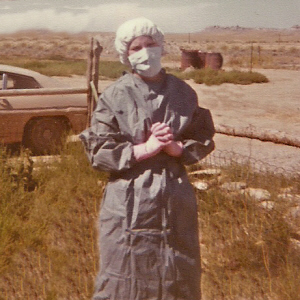 would absolutely recommend the Grand Canyon. We didn’t hike very far in, but the areas we were in were amazing. The next time I go, I want to hike down to the river. I know that wherever they hike, they will have a great time.
would absolutely recommend the Grand Canyon. We didn’t hike very far in, but the areas we were in were amazing. The next time I go, I want to hike down to the river. I know that wherever they hike, they will have a great time.
In many ways, Jennifer’s love of all things healthy has made her not only a nurse helping to bring life into the world, but also a person keeping her own life as strong and healthy as it can be. It’s a great way to live and one that will keep Jennifer, the grandma, in the lives of her three little grandchildren, Reagan, Hattie, and Bowen Parmely, for a long time to come. Today is Jennifer’s birthday. Happy birthday Jennifer!! Have a great day!! We love you!!
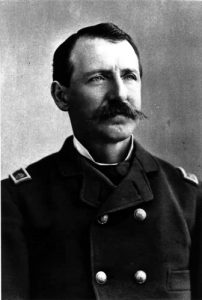 When people go missing these days, we are often not surprised. People seem to go missing all the time. Of course, most of them are murdered, or believed to be murdered. Very few are ever seen again, and as often as not, no one is ever prosecuted for their murder. This is not necessarily a new situation either. On February 1, 1896, one Albert Jennings Fountain and his eight year old son, Henry went missing near White Sands, New Mexico on their way home, after Fountain had attended a court term in Lincoln County. Mrs Fountain reported the two missing, and a search party was sent out the next day. On the Tularosa-Las Cruces road, about 45 miles from his home, the buckboard and team were found, along with Fountain’s papers, several empty cartridge casings, and two pools of blood. Missing were Fountain, his son, and Albert’s Winchester rifle.
When people go missing these days, we are often not surprised. People seem to go missing all the time. Of course, most of them are murdered, or believed to be murdered. Very few are ever seen again, and as often as not, no one is ever prosecuted for their murder. This is not necessarily a new situation either. On February 1, 1896, one Albert Jennings Fountain and his eight year old son, Henry went missing near White Sands, New Mexico on their way home, after Fountain had attended a court term in Lincoln County. Mrs Fountain reported the two missing, and a search party was sent out the next day. On the Tularosa-Las Cruces road, about 45 miles from his home, the buckboard and team were found, along with Fountain’s papers, several empty cartridge casings, and two pools of blood. Missing were Fountain, his son, and Albert’s Winchester rifle.
Albert Jennings Fountain was born in Staten Island, New York on October 23, 1838 to Solomon Jennings, a sea captain, and Catherine de la Fontaine Jennings, Albert grew up to go to Columbia College before traveling all over the world as a tutor. He then settled in California, where he worked at a newspaper before studying law in San Francisco. Though the reasons are unknown, Albert began to go by the name of “Albert Jennings Fountain,” an Anglicized version of his mother’s family name. In August, 1861 he enlisted in the Union Army and was commissioned as an officer in California Column. He participated in the Union conquest of the Confederate Territory of Arizona and fought at the Battle of Apache Pass.
During his time in the army, he married Mariana Perez in October, 1862 and the two would go on to have nine children. By the time he was discharged at the end of the Civil War, Albert had obtained the rank of captain. He and his family settled in El Paso, Texas, where he went to work for the United States Property Commission, which investigated and disposed of former Confederate property. Later he worked as a Customs Collector, was appointed an election judge, and the Assessor and Collector of Internal Revenue for the Western District of Texas. With this background, it is not surprising that he decided to try politics and in 1869, he won a seat in the Texas Senate. Fountain’s radical Republican views angered many Texas Democrats…my kind of guy. During the El Paso Salt War, Albert got into a shootout with a man named B. Frank Williams on December 7, 1870. Albert was wounded three times, but he killed Williams.
In 1875, the Fountain family moved to Mesilla, New Mexico, where his wife was from. It was here that Fountain began his law practice. Southern New Mexico, at that time, was still subject to frequent Indian raids and in 1878, Fountain became a captain in the first company of militia in southeast New Mexico, fighting in the campaigns against Chief Victorio and Geronimo. Continuing to serve in the militia, Fountain would reach the rank of colonel, a title that he was called for the rest of his life. In 1881, he was appointed to defend Billy the Kid in his charge for murder. In 1885, Fountain moved to Las Cruces to prosecute Federal land frauds. In 1888, he was elected to the New Mexico legislature, eventually becoming speaker of the house. Afterwards, he became a special prosecutor for livestock associations. In 1894 convicted 20 men for cattle rustling. His work as a politician and an attorney acquired numerous enemies for Albert, a fact that would prove to be fatal.
After an investigation into the disappearence, it was thought that a noted New Mexico gunman and rancher named Oliver M. Lee, along with two of his employees named Jim Gililland and William “Billy” McNew had perpetrated the crime. Eventually, all three were tried for the crime, but were acquitted for lack of evidence, namely the bodies, and the case remained open, with the Fountain bodies having never been found. Some historians also believe that the famed Sheriff Pat Garrett was assassinated while heavily investigating the Fountain murder, and that he might have been getting close to answering the age old question, “who done it”.

 Like most of the Schulenberg men, my brother-in-law Ron Schulenberg is a work-a-holic. When he isn’t working as a diesel mechanic at Wyoming Machinery, he is working on a car at his own house. This year Ron also put a roof on the family home and put up a fence around the yard. Like any work-a-holic, he spends an average of 16 working hours a day, and then comes in to spend time with his favorite people, his wife Rachel and his son Tucker, and the dogs of course. Weekends often find him working with his nephew, Barry or brother, Bob, both of whom are work-a-holics too. The men cut wood or work on cars. The main good news about all this for Rachel is the fact that she knows where to find him. That’s the way I always felt about Bob’s work.
Like most of the Schulenberg men, my brother-in-law Ron Schulenberg is a work-a-holic. When he isn’t working as a diesel mechanic at Wyoming Machinery, he is working on a car at his own house. This year Ron also put a roof on the family home and put up a fence around the yard. Like any work-a-holic, he spends an average of 16 working hours a day, and then comes in to spend time with his favorite people, his wife Rachel and his son Tucker, and the dogs of course. Weekends often find him working with his nephew, Barry or brother, Bob, both of whom are work-a-holics too. The men cut wood or work on cars. The main good news about all this for Rachel is the fact that she knows where to find him. That’s the way I always felt about Bob’s work.

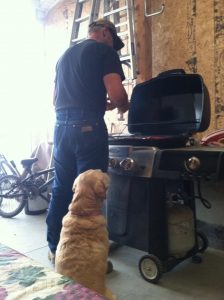
Ron loves grilling, and really knows his way around a barbeque grill. That seems to be another trait of the Schulenberg men…including my father-in-law, Walt Schulenberg, who was just like his sons and grandsons. Of course, these days, Ron has a helper with all his activities. His son Tucker, his sidekick, is right there doing whatever his dad is doing, be it working, playing, or grilling. They are best buddies, and they are perfectly happy to have each other to count on for help on their projects. It’s important to have an assistant for these things, and Tucker would rather be working with his dad, than almost anything else in the world.
While Ron is a work-a-holic, and like getting things done, he does like his relaxation time too. He enjoys 
 traveling. The family took a trip to New York a while back and really enjoyed Niagara Falls. Ron really enjoys his work, but the reality is that we work to make a better life for our family. Work is a means to an end…a better family life. I can’t picture Ron never getting out there and working…at least not until he is really, really old, but I think that if you ask Ron how he feels about the things he does in life, he would simply say, “I’d rather be camping!” Today is Ron’s birthday. Happy 50th birthday Ron!! Have a great day!! We love you!!
traveling. The family took a trip to New York a while back and really enjoyed Niagara Falls. Ron really enjoys his work, but the reality is that we work to make a better life for our family. Work is a means to an end…a better family life. I can’t picture Ron never getting out there and working…at least not until he is really, really old, but I think that if you ask Ron how he feels about the things he does in life, he would simply say, “I’d rather be camping!” Today is Ron’s birthday. Happy 50th birthday Ron!! Have a great day!! We love you!!

 Travel by ship was not always a safe mode of travel. Things like icebergs, wars, storms, and seashores were known to bring to an end a voyage, that was otherwise very enjoyable. Most people remember the Unsinkable Molly Brown, who was really Margaret Tobin, mostly because of all the publicity and even a musical. Surviving the sinking of the Titanic, while an amazing feat, was something that 705 other people did too. The stories and musical were a way of remembering the tragedy. As amazing as surviving a ship sinking in those days was, there is something that is far more amazing!!
Travel by ship was not always a safe mode of travel. Things like icebergs, wars, storms, and seashores were known to bring to an end a voyage, that was otherwise very enjoyable. Most people remember the Unsinkable Molly Brown, who was really Margaret Tobin, mostly because of all the publicity and even a musical. Surviving the sinking of the Titanic, while an amazing feat, was something that 705 other people did too. The stories and musical were a way of remembering the tragedy. As amazing as surviving a ship sinking in those days was, there is something that is far more amazing!!
Surviving, not one, but three ship accidents in those days. In 1910, Violet Jessop began working as an ocean liner stewardess and nurse for the White Star line. She was on board when RMS Olympic sailed on September 20, 1911. The Olympic was a luxury ship that was the largest civilian liner at that time. Olympic left from Southampton and collided with the British warship HMS Hawke. There were no fatalities when Olympic sand, and despite damage, the ship was able to make it back to port without sinking. She doesn’t really count this one, because it didn’t sink, but then it did collide with another ship. She didn’t think that one was such an amazing feat, but I’d say that counts. Jessop was then a stewardess on the RMS Titanic April 10, 1912, when she was 24 years old. Four days later, on April 14, it struck an iceberg in the North Atlantic, a story with we all know very well. Titanic sank a little more than two hours after the collision. Jessop described in her memoirs how she was ordered up on deck, because she was to function as an example of how to behave for the non-English speakers who could not follow the instructions given to them. She watched as the crew loaded the lifeboats. She was later ordered into lifeboat 16; and as the boat was being lowered, one of the Titanic’s officers gave her a baby to look after. The next morning, Jessop and the rest of the survivors were rescued by the RMS Carpathia. According to Jessop, while on board the Carpathia, a woman, presumably the baby’s mother, grabbed the baby she was holding and ran off with it without saying a word. Records indicate that the only baby on boat 16 was Assad Thomas, who was handed to Edwina Troutt, and later reunited with his mother on the Carpathia. Then, during the First World War, she served as a stewardess for the British Red Cross. On the morning of November 21, 1916, she was on board the HMHS Britannic, that had been converted into a hospital ship, when it sank in the Aegean Sea due to an unexplained explosion. The Britannic sank within 57 minutes, killing 30 people. British authorities decided that the ship was either struck by a torpedo or hit a mine planted by German forces.
After the war, Jessop continued to work for the White Star Line, before joining the Red Star Line and then the 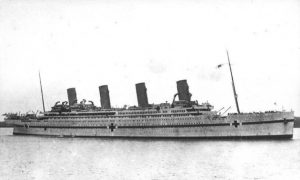
 Royal Mail Line again. During her tenure with Red Star, Jessop went on two around the world cruises on that company’s largest ship, the Belgenland. In her late thirties, Jessop had a brief marriage, and in 1950 she retired to Great Ashfield, Suffolk, where my dad had been stationed during World War II. Jessop, often winkingly called “Miss Unsinkable,” died of congestive heart failure in 1971 at the age of 83.
Royal Mail Line again. During her tenure with Red Star, Jessop went on two around the world cruises on that company’s largest ship, the Belgenland. In her late thirties, Jessop had a brief marriage, and in 1950 she retired to Great Ashfield, Suffolk, where my dad had been stationed during World War II. Jessop, often winkingly called “Miss Unsinkable,” died of congestive heart failure in 1971 at the age of 83.
 I’ve never really thought of my Aunt Dixie Richards as being exactly shy, but maybe that’s because I’ve known her all my life. She never seemed shy to me, or to any of the other kids in the family. Nevertheless, when I watched her in an old home movie my parents shot when they got one of those “new fangled” movie cameras, she seemed very shy. Of course, none of the family really wanted to have a home movie taken of them…probably because it was such a new thing, but in watching Aunt Dixie, I saw a bit of shyness on her face. I think that maybe I’m like Aunt Dixie in some ways, because I’m a bit of a shy girl too…until I get to know people.
I’ve never really thought of my Aunt Dixie Richards as being exactly shy, but maybe that’s because I’ve known her all my life. She never seemed shy to me, or to any of the other kids in the family. Nevertheless, when I watched her in an old home movie my parents shot when they got one of those “new fangled” movie cameras, she seemed very shy. Of course, none of the family really wanted to have a home movie taken of them…probably because it was such a new thing, but in watching Aunt Dixie, I saw a bit of shyness on her face. I think that maybe I’m like Aunt Dixie in some ways, because I’m a bit of a shy girl too…until I get to know people.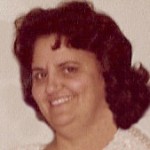
As one of the younger children in a family of nine children, Aunt Dixie saw her older siblings get married and head off to start families. I’m sure that also gave her the opportunity to babysit her nieces and nephews. In many ways, I think that babysitting the little ones probably prepared her for having children of her own, as well as, babysitting a number of children of nieces and nephews later on. I didn’t know that she babysat so many children. I found that out last year, and I just think that is really awesome. For parents, having a babysitter that you can trust is vital.

Aunt Dixie also has grandchildren now too. She has four grandsons, and one granddaughter. She wasn’t sure she was going to ever get a granddaughter, but the last one was finally a girl. The boys, being a little older, are often off doing their own things, so this summer, Aunt Dixie has spent a lot of time with her granddaughter, Mayme Williams. They have had a lot of fun, and now that school is ready to begin, Aunt Dixie told me that she is feeling pretty sad that her time with Mayme is ending, but at six years old, she has to go to first grade. At least Aunt Dixie will have time with the kids after school, and that always makes her feel better. Today is Aunt Dixie’s 74th birthday. Happy birthday Aunt Dixie!! Have a great day!! We love you!!

 Prior to 1956, the road and highway system in the United States, well…lets just say, it left something to be desired…like passable roads for instance. Yes, there were a few highways, but on June 29, 1956, President Dwight Eisenhower signed the Federal-Aid Highway Act of 1956. This bill changed the highways by creating a 41,000-mile “National System of Interstate and Defense Highways” that would, according to Eisenhower, eliminate unsafe roads, inefficient routes, traffic jams and all of the other things that got in the way of “speedy, safe transcontinental travel.” At the same time, highway advocates argued, “in case of atomic attack on our key cities, the road net [would] permit quick evacuation of target areas.” The 1956 law, which allocated more than $30 billion for the construction, declared that the construction of an elaborate expressway system was “essential to the national interest.” The plan included a lot of discussion on things like where exactly the highways should be built, and how much of the cost should be carried by the federal government versus the individual states. Several competing bills went through Congress before 1956, like the ones spearheaded by the retired general and engineer Lucius D Clay, Senator Albert Gore Sr, and Representative George H Fallon, who called his program the “National System of Interstate and Defense Highways,” thereby linking the nationwide construction of highways with the preservation of a strong national defense.
Prior to 1956, the road and highway system in the United States, well…lets just say, it left something to be desired…like passable roads for instance. Yes, there were a few highways, but on June 29, 1956, President Dwight Eisenhower signed the Federal-Aid Highway Act of 1956. This bill changed the highways by creating a 41,000-mile “National System of Interstate and Defense Highways” that would, according to Eisenhower, eliminate unsafe roads, inefficient routes, traffic jams and all of the other things that got in the way of “speedy, safe transcontinental travel.” At the same time, highway advocates argued, “in case of atomic attack on our key cities, the road net [would] permit quick evacuation of target areas.” The 1956 law, which allocated more than $30 billion for the construction, declared that the construction of an elaborate expressway system was “essential to the national interest.” The plan included a lot of discussion on things like where exactly the highways should be built, and how much of the cost should be carried by the federal government versus the individual states. Several competing bills went through Congress before 1956, like the ones spearheaded by the retired general and engineer Lucius D Clay, Senator Albert Gore Sr, and Representative George H Fallon, who called his program the “National System of Interstate and Defense Highways,” thereby linking the nationwide construction of highways with the preservation of a strong national defense.
For President Eisenhower, however, who had participated in the United States Army’s first transcontinental motor convoy in 1919, during World War II, there was a realization that the country needed a better highway system. He had seen Germany’s Autobahn network, and admired the efficiency of it. In January 1956, Eisenhower repeated his 1954 State of the Union address call for a “modern, interstate highway system.” Later that month, Fallon introduced a revised version of his bill as the Federal Highway Act of 1956. It provided for a 41,000 mile national system of interstate and defense highways to be built over 13 years, with the federal government paying for 90 percent, or $24.8 billion. To raise funds for the project, Congress increased the gas tax from two to three cents per gallon and impose a series of other highway user tax changes. On June 26, 1956, the Senate approved the final version of the bill by a vote of 89 to 1. Senator Russell Long, who opposed the gas tax increase, cast the single “no” vote. That same day, the House approved the bill by a voice vote, and three days later, Eisenhower signed it into law.
The highway construction began almost immediately. With the construction came the employment of tens of thousands of workers and the use of billions of tons of gravel and asphalt. The system fueled a surge in the interstate trucking industry. That was good, but soon it pushed aside the railroads to gain the lion’s share of the domestic shipping market. Interstate highway construction also fostered the growth of roadside businesses such as restaurants, most of which were fast-food chains, hotels and amusement parks. By the 1960s, an estimated one in seven Americans was employed directly or indirectly by the automobile industry. Not only 
 that, but America had become a nation of drivers. Legislation has extended the Interstate Highway Revenue Act three times. Many historians say it is Eisenhower’s greatest domestic achievement. Many called the years between 1956 and 1966 “the Greatest Decade.” Still, critics of the system have pointed to its less positive effects, including the loss of productive farmland and the demise of small businesses and towns in more isolated parts of the country. I suppose that’s true, but it was inevitable.
that, but America had become a nation of drivers. Legislation has extended the Interstate Highway Revenue Act three times. Many historians say it is Eisenhower’s greatest domestic achievement. Many called the years between 1956 and 1966 “the Greatest Decade.” Still, critics of the system have pointed to its less positive effects, including the loss of productive farmland and the demise of small businesses and towns in more isolated parts of the country. I suppose that’s true, but it was inevitable.

